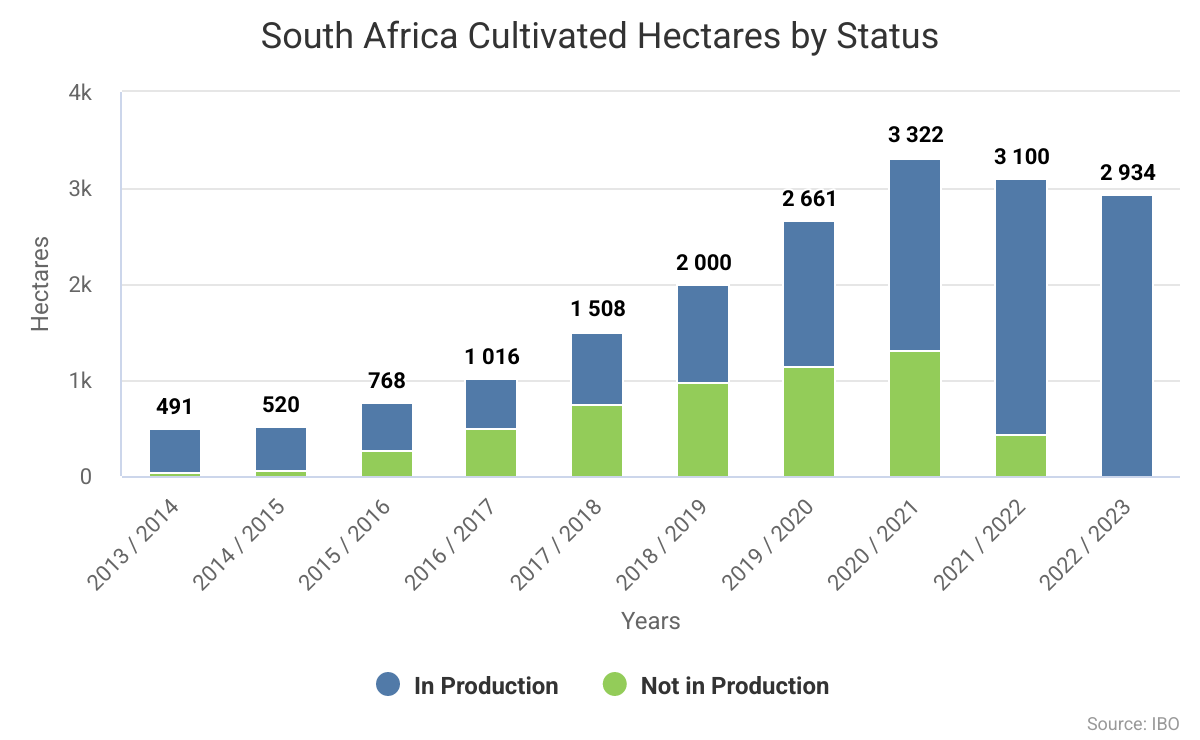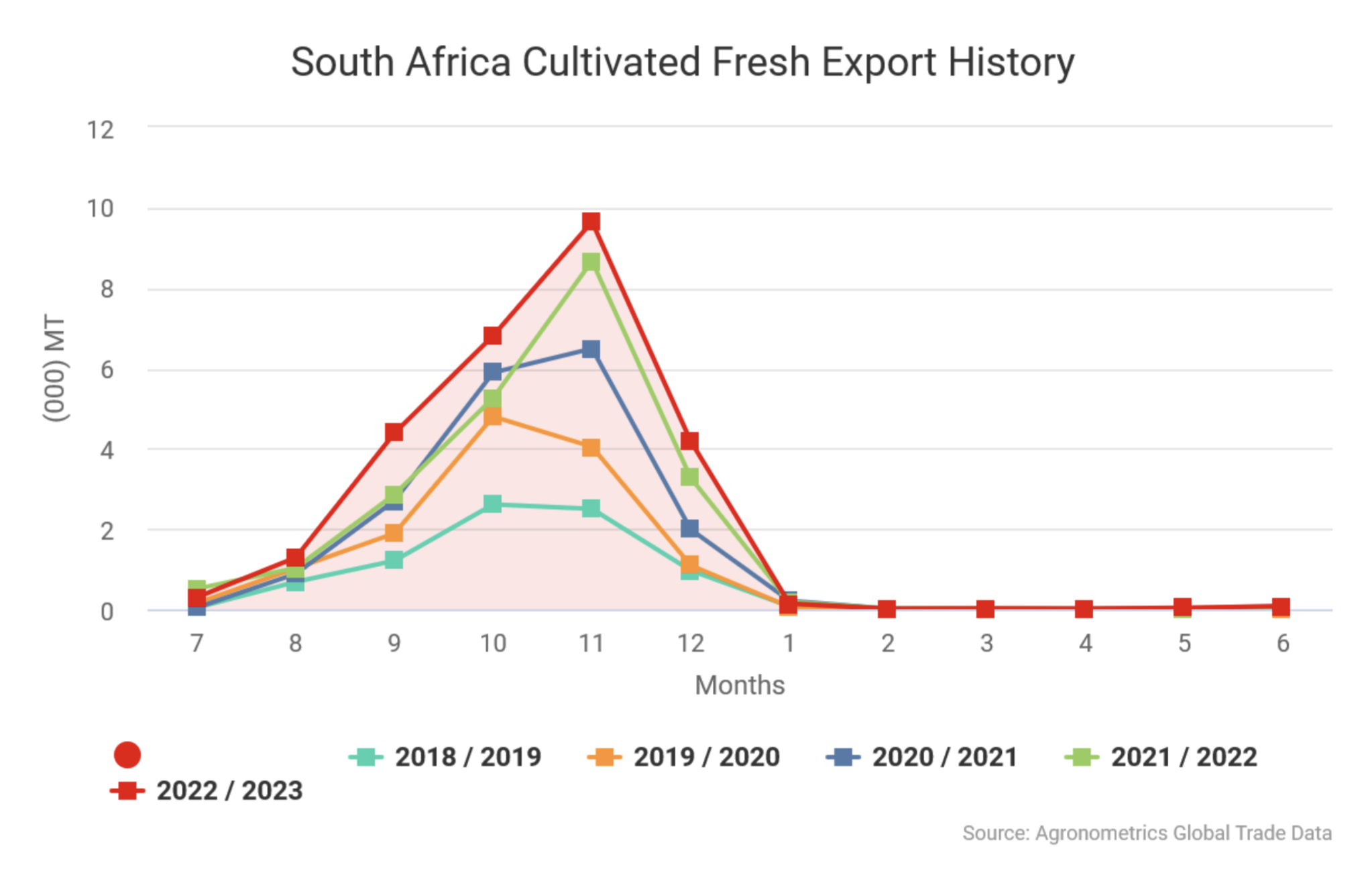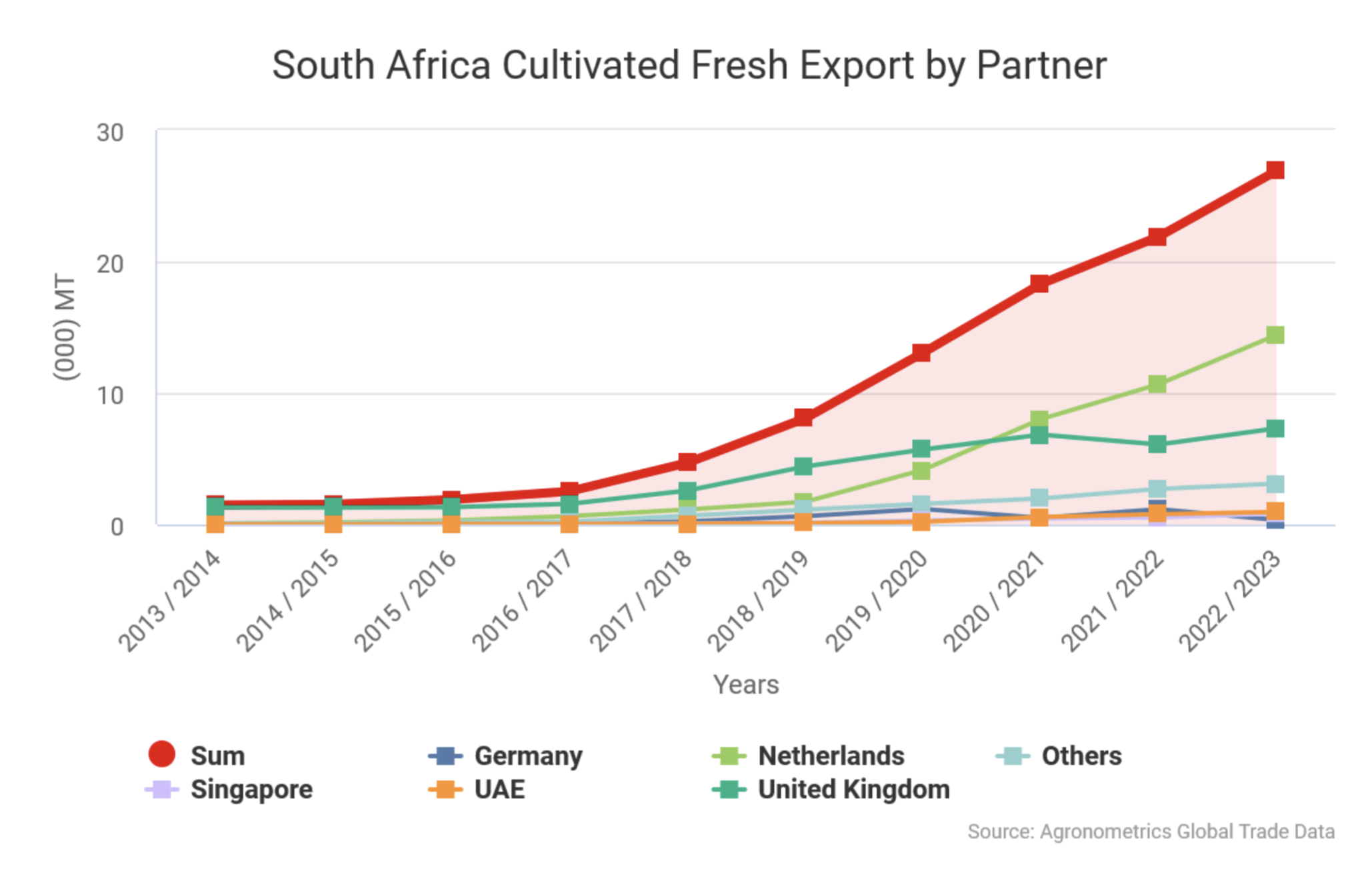Cultivating Success: The Evolution and Prospects of South Africa’s Blueberry Industry
The South African blueberry industry has been on a steady growth trajectory in recent years, driven by various factors that have contributed to its success. While the number of hectares under blueberry production has remained relatively stable, significant changes within the industry, such as the introduction of new varieties and improved production methodologies, have led to increased yield and improved product quality.

Since 2020, the area dedicated to blueberry production in South Africa has fluctuated around 3,000 hectares. However, production has steadily increased, with approximately 20,000 tons produced in 2020 and an expected yield of over 30,000 tons in the current season. The industry has embraced new blueberry varieties, leading to a more diverse selection and improved product quality. This shift aligns with consumer preferences globally and has allowed South African producers to cater to specific market demands.
The South African blueberry industry is relatively nascent compared to some of its global counterparts. Nevertheless, it has undergone significant advancements in production methodologies and techniques. Over the past five years, producers have streamlined their processes, resulting in higher-quality blueberries. These improvements have contributed to the industry’s competitiveness in the global market and have allowed South Africa to position itself as a reliable supplier of high-quality blueberries. “The learning curve that we continue to go on has been fairly steep. And I think over the last five or so years, we’ve tightened up a lot on production methodologies and production techniques and have been able to produce significantly better quality berries at the end of the day, ” says Brent Walsh, CEO of Berries ZA.
In 2022, the South African blueberry industry faced a labor strike at the ports, which significantly impacted exports. The two-week strike had far-reaching consequences, affecting the sustainability of several industry players. “The labor issues that were dealt with last year resulted in a three year labor agreement. So we are not expecting any labor issues this year because of that agreement. Not that that’s any guarantee, but if there is anything, it would be extremely limited and certainly not to the extent of last year, ” says Brent.

Adverse weather conditions in the Western Cape have caused delays this season. These delays have presented challenges in meeting market demand promptly. “I think probably the biggest challenge has been the timing of getting our peak volumes to market. And that has been out of our control with the slightly cooler and wetter weather in the southern provinces of South Africa and the Western Cape, where most of our production occurs. We’ve had fairly cool and fairly wet winter conditions, which have resulted in a slight delay by probably about an average of around three weeks, possibly as much as four weeks in some areas to get our peak production harvested and out to market, ” says Brent.
The decline in Peruvian blueberry exports, attributed to the impact of El Niño, has created a unique opportunity for South Africa. With a potential 50% reduction in Peruvian exports, South African blueberry producers aim to fill this gap in the market. The decreased supply has led to higher demand and, consequently, attractive pricing for South African blueberries. As peak production volumes come online, South Africa seeks to capitalize on this opportunity and solidify its presence in European markets. “Within the next couple of weeks we should see our peak volumes coming online. And hopefully that gap that Peru has left is still very much in play and we can fill those gaps in the market, ” Brent said.
The initial export forecast for the current season stands at 25,000 tons, with no significant adjustments anticipated. Producers have reported excellent quality. While exceeding this volume would be ideal, it remains a realistic expectation at this stage, barring any unforeseen challenges.

The South African blueberry industry has successfully adapted to evolving consumer preferences, both domestically and internationally. Consumer demands vary by market, necessitating an array of blueberry varieties and qualities. Advances in genetics have allowed South African producers to meet these expectations, while improved market intelligence and export strategies ensure that the right varieties reach the right markets at the right time. “The challenge now is to match the market with the correct variety in terms of the quality of production. Getting that product to the market in the expected time frame, whether it’s air freight or sea freight, makes a big difference, ” says Brent.
While the Western Cape accounts for over 70% of blueberry production in South Africa, the country’s diverse climate offers opportunities in different regions. Higher-altitude areas in the north, such as Limpopo and Mpumalanga, have proven suitable for blueberry cultivation, providing alternatives and extending the production season. This regional diversity enhances the industry’s resilience and capacity to serve global markets effectively.
The future of the South African blueberry industry is promising; continued support for market access and export programs is crucial for sustained growth. While hectares under production are expected to increase gradually, the focus remains on enhancing yields and maintaining product quality. Market competitiveness hinges on South Africa’s ability to deliver consistently high-quality blueberries, maintain its positive reputation in global markets, and align its export timing with market demand.
Berries ZA, a producer-led organization, plays a pivotal role in supporting the South African blueberry industry. It funds and initiates research, collaborates with academic institutions, conducts workshops and symposiums, and disseminates valuable information to growers. By facilitating knowledge sharing and promoting best practices, Berries ZA contributes to the industry’s growth, sustainability, and competitiveness.
As Peruvian blueberry exports are expected to rebound in the future, Brent acknowledges the need for a proactive approach. Maintaining a strong brand for quality produce, optimizing export timing, and expanding market presence will be key strategies to remain competitive when Peruvian exports recover. “I think we need to be realistic in what our unique selling point is, and that has to remain on quality, ” Brent says.
South Africa is actively pursuing access to markets in India and Israel. While progress varies, ongoing engagement with plant health departments in both countries aims to finalize export protocols. Trials and assessments will follow, with the goal of exporting blueberries to these markets in the near future. Access to new markets is essential for industry growth and diversification.
The South African blueberry industry’s growth in recent years reflects its resilience and adaptability. Through advancements in production, commitment to quality, and proactive market strategies, South Africa has solidified its position as a significant player in the global blueberry market. Challenges persist, but with continued support from organizations like Berries ZA and a strategic approach to market competitiveness, the South African blueberry is making its mark on the global stage.
International Blueberry Organization
The charts and content presented in the story build upon the work published in the IBO’s 2023 Global State of the Blueberry Industry Report. For more information you can download the entire report for free at:
2023 IBO Report






